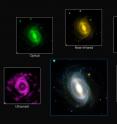Charting the slow death of the Universe
The study, which is part of the Galaxy And Mass Assembly (GAMA) project, the largest multi-wavelength survey ever put together, involved many of the world's most powerful telescopes [1]. "We used as many space and ground-based telescopes as we could get our hands on to measure the energy output of over 200 000 galaxies across as broad a wavelength range as possible," says Simon Driver ICRAR, The University of Western Australia), who heads the large GAMA team.
The survey data, released to astronomers around the world today, includes measurements of the energy output of each galaxy at 21 wavelengths, from the ultraviolet to the far infrared. This dataset will help scientists to better understand how different types of galaxies form.
All the energy in the Universe was created in the Big Bang, with some portion locked up as mass. Stars shine by converting mass into energy, as described by Einstein's famous equation E=mc2 [2]. The GAMA study sets out to map and model all of the energy generated within a large volume of space today and at different times in the past.
"While most of the energy sloshing around in the Universe arose in the aftermath of the Big Bang, additional energy is constantly being generated by stars as they fuse elements like hydrogen and helium together,"" Simon Driver says. "This new energy is either absorbed by dust as it travels through the host galaxy, or escapes into intergalactic space and travels until it hits something, such as another star, a planet, or, very occasionally, a telescope mirror."
The fact that the Universe is slowly fading has been known since the late 1990s, but this work shows that it is happening across all wavelengths from the ultraviolet to the infrared, representing the most comprehensive assessment of the energy output of the nearby Universe.
"The Universe will decline from here on in, sliding gently into old age. The Universe has basically sat down on the sofa, pulled up a blanket and is about to nod off for an eternal doze," concludes Simon Driver.
The team of researchers hope to expand the work to map energy production over the entire history of the Universe, using a swathe of new facilities, including the world's largest radio telescope, the Square Kilometre Array, which is due to be built in Australia and South Africa over the next decade.
The team will present this work at the International Astronomical Union XXIX General Assembly in Honolulu, Hawai`i, on Monday 10 August 2015.
Source: International Astronomical Union
Articles on the same topic
- Scientists measure slow death of the UniverseMon, 10 Aug 2015, 21:03:06 UTC
- Charting the slow death of the UniverseMon, 10 Aug 2015, 21:02:56 UTC
Other sources
- Study: Universe is slowly dyingfrom UPITue, 11 Aug 2015, 18:21:16 UTC
- The universe is slowly dying, galaxy survey confirmsfrom CBC: Technology & ScienceTue, 11 Aug 2015, 15:00:19 UTC
- Don't panic, but the universe is slowly dyingfrom PhysorgTue, 11 Aug 2015, 11:50:16 UTC
- It's Official: The Universe Is Dying Slowlyfrom Live ScienceTue, 11 Aug 2015, 5:29:28 UTC
- Massive Study Confirms Universe Is "Slowly Dying"from MSNBC: ScienceTue, 11 Aug 2015, 0:00:06 UTC
- It's Official: The Universe Is Dying Slowlyfrom Space.comMon, 10 Aug 2015, 21:00:22 UTC
- Charting the slow death of the universefrom Science DailyMon, 10 Aug 2015, 21:00:10 UTC
- RIP Universe - Your Time Is Coming… Slowly | Videofrom Space.comMon, 10 Aug 2015, 20:30:17 UTC
- The universe is in a long, slow decline to darknessfrom Science NOWMon, 10 Aug 2015, 20:20:06 UTC
- Charting the slow death of the Universefrom PhysorgMon, 10 Aug 2015, 20:00:38 UTC
